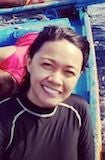 When Annalyn Ardoña first began producing segments for the GMA Network’s Born to be Wild television show in the Philippines, she felt conflicted about leaving the political beat to cover the environment.
When Annalyn Ardoña first began producing segments for the GMA Network’s Born to be Wild television show in the Philippines, she felt conflicted about leaving the political beat to cover the environment.
“My other journalist friends were tackling corruption, poverty, and child labor,” explained Ardoña, an alumna of Metcalf’s 2015 Annual Science Immersion Workshop for Journalists. “I felt like I wasn’t doing something valid on the environmental beat. But as I understood more of the issues, I realized the environment is the one issue that we all should be talking about.”
Ardoña said the environment is an important issue in the Philippines, where more than a quarter of the population lives below the poverty line.
“I see the degradation of the environment as one of the main reasons Filipinos are poor right now,” said Ardoña. “If you address the problems in the ocean such as overfishing, you address hunger, you address poverty. If you address the problems in the forest like deforestation, you address water availability, flood control, and the living quality of Filipinos.”
Producing segments for Born to Be Wild puts Ardoña in regular contact with scientists, which has made her keenly aware of the communications gap between scientists and journalists.
“I wanted to attend the Metcalf workshop to be able to understand how scientist think,” said Ardoña. At the Metcalf workshop she learned about the latest climate change research, how to read scientific journal articles, and how journalists can connect and build relationships with scientists.
“I learned why scientists give you the most boring answers, it’s because they are trying to be as accurate as possible. Journalists want something more sensational,” she added.
Ardoña pointed to an article she wrote about climate change which she described as “climate change for dummies,” as an example of how Metcalf’s workshop influenced her reporting. She noticed that news stories about the U. N. Climate Talks in Paris were written predominantly in English and were difficult for non-scientists to understand. She set out to change that by writing an article about the Paris Talks in Filipino and explaining the complex science in a way that her readers could understand.
Using humor, Ardoña compared climate change to a love story between the Earth and greenhouse gasses. “I was able to explain climate change and liken it to love or being rejected, because those kinds of analogies work with news audiences in the Philippines,” she said. “I was able to explain climate change in that way because Metcalf explained it so clearly to me.”
“The Metcalf workshop was amazing and enlightening,” Ardoña reflected.
Ardoña looks forward to learning more science, and perhaps taking a class in marine biology so that she can become a stronger journalist and a resource for her news audience on important environmental topics.
Read more alumni profiles